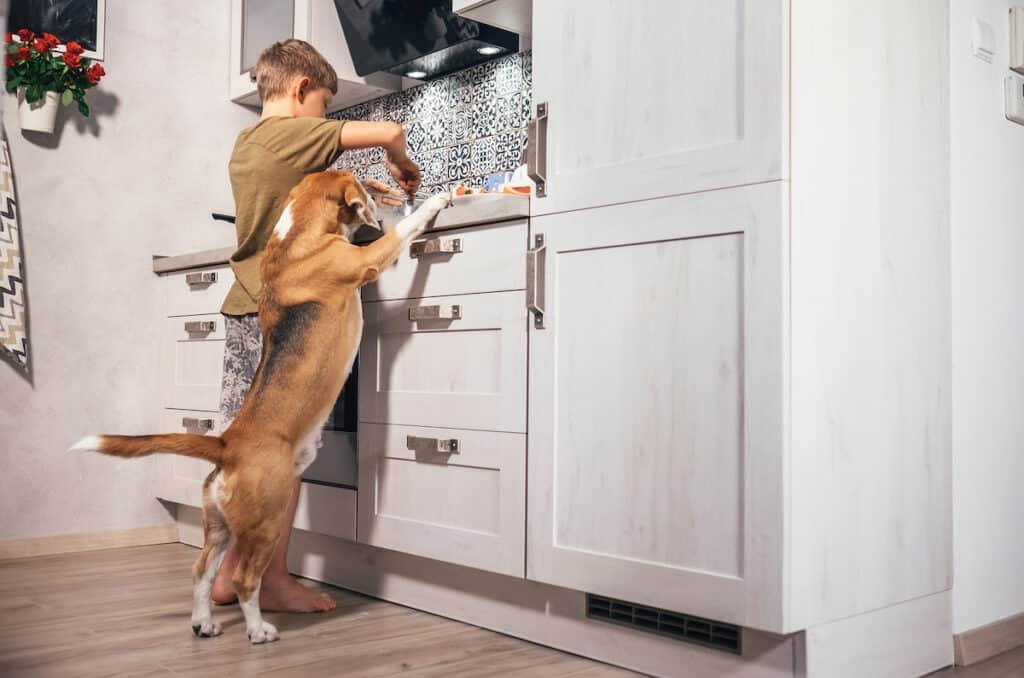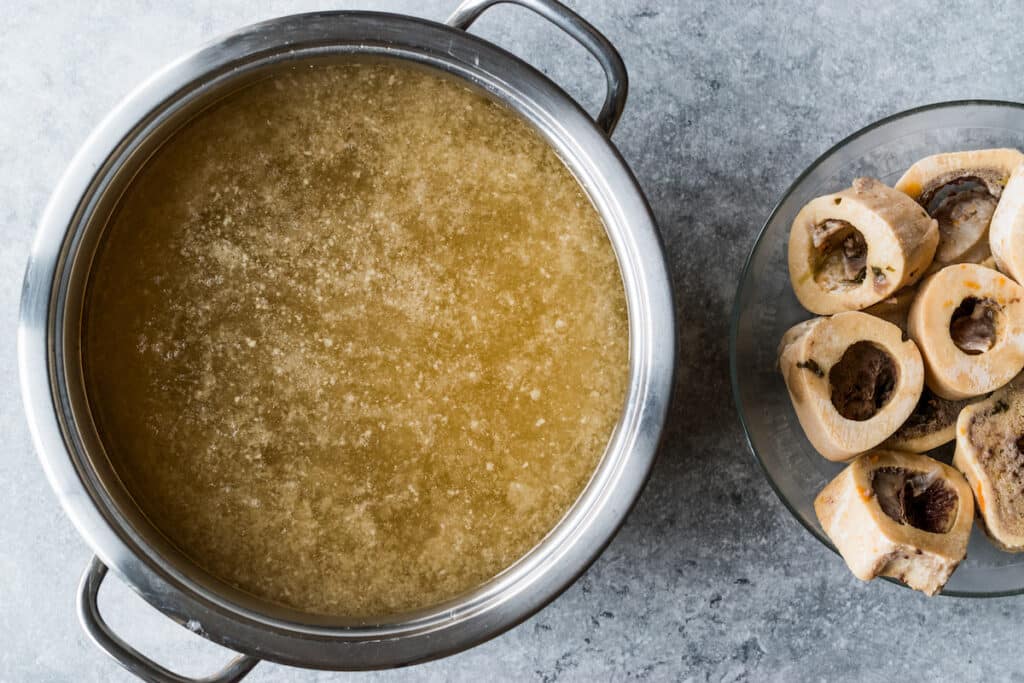We’ve been making food for our dogs from scratch for the past year or so. Why? Because our dog Sadie has many food allergies and store-bought kibble left her itchy and scratchy. Our vet put her on an allergen-free food that we bought through the office, but it was super expensive. Plus, our other dog Oscar didn’t like it so we wasted a lot of money.
Then my husband got the idea to start making the dogs food using our Instant Pot. Basically, once a week we put some sort of protein (chicken, pork, beef, turkey) in the Instapot with carrots, zucchini and peas, and cook on the beef stew setting. In addition, we make a batch of rice separately as part of their twice-daily meals.
Given all of the cooking we’re already doing, I was intrigued when my writer friend Jessica Haggard, who writes the Primal Edge Health blog, told me how she makes bone broth for dogs her dogs. Here’s what she told me.

Benefits of bone broth for dogs
First of all, bone broth may give your dog a range of possible benefits, from joint support to better gut health. She had me at “joint support.”
Why? Because in the past two years, Sadie had two TPLO (tibial-plateau-leveling osteotomy) surgeries on her back legs. TPLO is basically the doggie version of an ACL repair.
Sadie’s surgeon told us that we need to give her joint supplements to help deal with any arthritis she might develop in those joints. However, Sadie’s not a big fan of the Dasuquin soft chews. So, she rarely eats them. If I could make bone broth for the same benefits, this could be a game-changer for our four-legged family member.
This savory liquid is high in collagen, amino acids, calcium, phosphorus, magnesium, selenium, vitamin A and more, according to the USDA. Here are some other benefits.
Bone broth can supports joints
Collagen found in bone broth may help maintain joint flexibility. This could reduce the risk of arthritis.
Improves gut health
As demonstrated in a 2014 animal study, the gelatin in broth is generally soothing and healing the gut lining. It may positively remedy a leaky gut, diminish food allergies and reduce digestive issues such as diarrhea or constipation.
Aids in liver detoxification
Glycine is the essential amino acid that supports liver health. The abundance of glycine found in broth may positively affect detoxification.
Bone broth might entice reluctant eaters
This describes my dog Oscar perfectly. While Sadie is gobbling down whatever food we put in front of her, Oscar is weighing his options. It’s gotten to the point where we have to add shredded cheese to his home-cooked food — and he has to see us putting on his dish — for him to start eating.
If bone broth could stimulate a dog’s appetite and lure my picky eater to their bowl, I’m in.
Contributes to hydration
Adding broth to the dog bowl is one way to increase liquid consumption and keep a dog hydrated.
How to make bone broth
Bone broth may be the simplest soup you could ever make. It is the liquid made by simmering beef or chicken bones in water over a long period
Bone broth for dogs is usually prepared differently than bone broth for humans. Dog broth should be low-sodium, so skip the salt even if it’s a high-quality mineral-rich salt. Furthermore, you want to avoid adding onion and garlic. These are on the list of foods that are toxic to dogs and that they cannot eat.
If you’re getting store-bought bone broth, always read the ingredient list on the package or label. You want to make sure that there’s nothing in there that can hurt your pup.
“Anytime I make homemade bone broth, I make a small separate batch for the dog using just bones and without flavoring ingredients like onions or garlic,” says Gina Matsoukas of What Can My Dog Eat? “I add it to her regular food, and she gobbles it up even faster than usual. I think it’s one of many things we do that results in her shiny coat, high energy and overall good health.”
Steps to make bone broth

Here is an easy step-by-step process for making homemade bone broth for dogs. This recipe is good for humans, too.
- Start with about 2 pounds of beef marrow bones, a few carrots, 2 celery stalks and 2 sprigs of rosemary.
- Add the ingredients to a large stock pot. Cover them with approximately 3 quarts of water and bring it to a boil. Then, lower the heat to a simmer and maintain that for 12 hours or overnight. Skim off any foam or impurities that may rise during cooking.
- Remove the pot from heat and let the liquid cool enough to handle.
- Strain the broth through a fine mesh sieve and discard the cooked ingredients. Never feed dogs cooked bones.
- Serve immediately, store portions for the next 3 days in the refrigerator and freeze the leftovers.
You can also adapt this recipe to make slow cooker bone broth or finish it even faster in a pressure cooker. Yeah, I can use the Instant Pot to make bone broth after all. Both alternatives offer the convenience of hands-free countertop cooking.
Simplifying the recipe down to an ultra-simple bone broth with just bones and water can also work. It’s all a matter of preference, so find the best method for you.
Homemade bone broth is an excellent option because you can control the ingredients and know exactly what goes in each batch. However, you can also buy pre-made broth at select stores and online if you’re busy or don’t want to fuss over it.
Serving bone broth to your dog
There are a few things to remember when serving a dog broth. First, make sure the broth is completely cool.
Then, decide to use broth as a meal topper by pouring it over their food or serving it on its own as a refreshing drink. Some dogs may also enjoy frozen broth as a treat on a hot day.
Begin slowly and gradually increase the serving size over time. Ask your vet for guidance and lean on their expertise when needed. Remember that bone broth is supplementary feed and not intended as a meal replacement.
Storing bone broth for future use
Proper storage is key if you have a large batch of bone broth or want to save portions for later. Allow the broth to cool completely before transferring it into airtight containers or ice cube trays for freezing.
Label each container with the date and contents so that you can quickly identify them later on. Bone broth can last up to three months when stored correctly in the freezer.
When ready to use the frozen bone broth, thaw it in the refrigerator overnight or defrost it using gentle heat on the stovetop. By following these simple tips, your dog can get all the benefits of bone broth and you can seamlessly add the prep into your routine.
Finally, when making bone broth, you aren’t limited to just using beef bones. Dan Morris of Fire and Saw makes bone broth for his dog Bingo using chicken, lamb or beef.
“We keep the first boil of the chicken, lamb or beef bones for ourselves,” he says, “and then reboil a second time for Bingo. It’s still rich and gelatinous. Everyone comments on how amazing his coat looks!”
In conclusion
Bone broth for dogs can be a powerful addition to their diet, offering a range of benefits for their overall health. From promoting joint health and digestion to boosting their immune system, bone broth provides essential nutrients supporting your furry friend’s vitality.
By following the simple steps outlined in this article, you can easily prepare homemade bone broth for your pups and ensure they receive all the goodness it offers. Incorporating bone broth into your dog’s diet is an easy way to enhance their health naturally while providing them with a tasty treat they’ll love.
Of course, I’m going to consult Sadie and Oscar’s veterinarian before making and giving them bone broth. This is smart for any pet parent to do before introducing a new food into your dog’s diet, especially if they have specific dietary restrictions or health conditions like Sadie does.
Portions of this article originally appeared on Food Drink Life.

